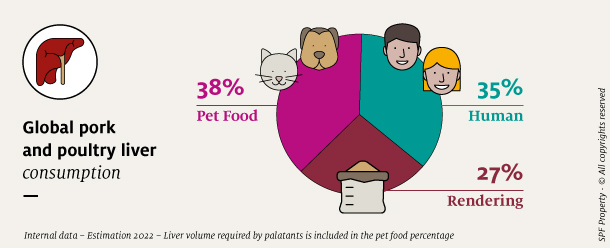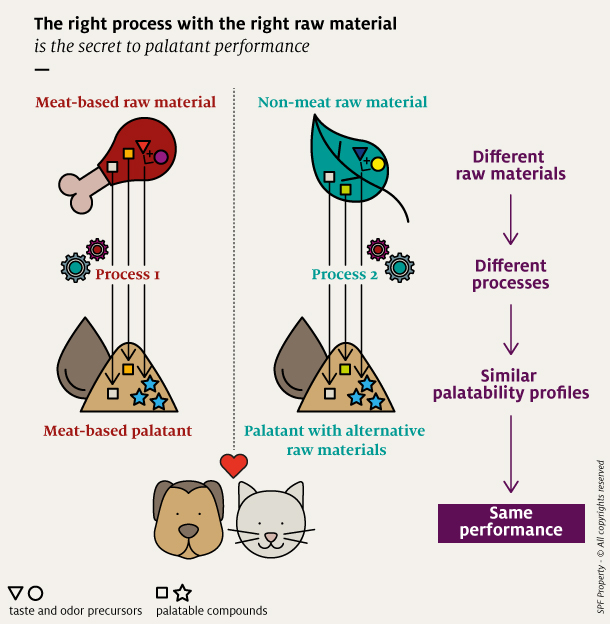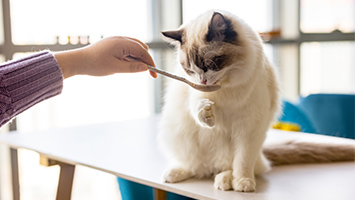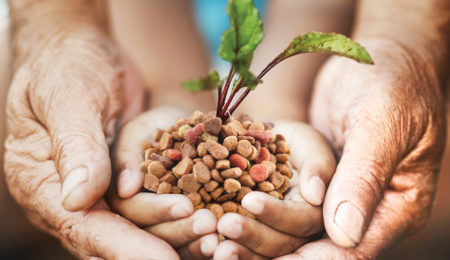I won’t tell you now that meat is no longer required.
Kitty has not turned vegetarian, and Max still craves a juicy bone. But what I can tell you is that producing palatants requiring less animal protein, or even no animal protein, is possible. And not only it is a reality, it’s a valuable one.
Performance, security, sustainability — palatants from alternative sources have multiple advantages. Discover why less meat is more.
NB: There are several definitions of “meat” depending on the regulations of various countries. In this article, “meat” refers to skeletal muscles and organs in the great cavity of the body.
1- Reducing animal protein use is inescapable
There won’t be enough animal protein to meet rising pet food and food needs.
Following the strong increase in pet population, the volume of pet food produced has grown dramatically. The pet food industry always needs more raw materials, in particular animal protein, which must also be shared with the human population.

Poultry and pork livers are some of the main raw materials used to produce palatants. They also represent an important part of pet food formulas, especially in canned pet food.
Besides its indisputable palatability and nutritional potential, liver has been available and economical for a long time, making it an ideal protein source for pets.
Global liver demand is growing 3 times faster than supply
But times have changed, and forecasts are clear: global liver demand is growing 3 times faster than supply*. If nothing changes, shortages will become the norm for pet food players.
Diversifying protein sources in pet food is the only solution to continue feeding the growing populations of both pets and humans.
* Internal data – Estimation 2022 – Liver volume required by palatants is included in the pet food percentage
2 – Palatants with alternative raw materials are effective
Palatants don’t need to bring meat, they need to bring smell and taste!
This is why palatability enhancers made with less animal protein raw materials can be so effective.
To increase pet food palatability, palatants must stimulate Kitty and Max’s nose and tongue with flavors and aromas they love, whatever the source.
Palatants don’t need to bring meat, they need to bring smell and taste
It is true that meat raw materials such as poultry and pork livers are particularly adapted to produce compounds that pets crave.
But it’s also true that it is possible to obtain similar palatable compounds targeted to cats and dogs’ preferences from alternative sources. This requires adapting the process based on the taste and odor precursors present in the raw material.
Several sources such as plant-based raw materials or yeasts have for instance the potential to bring a high level of palatability. They are already successfully used to replace some or all of meat-based raw materials in palatants without altering performance.

3- Alternative raw materials are comforting
Using alternatives to animal protein in palatant formulas brings valuable benefits.
 Secure delivery
Secure delivery
Besides their palatability potential, alternative raw materials used to replace meat-based ones are usually more available.
Reducing the amount of meat raw materials in the palatant formula reduces the risk of shortage.
 Price stability
Price stability
The higher availability of alternative raw materials makes them less sensitive to price volatility.
Palatants with lower amounts of animal protein can thus have a stable price, allowing palatant producers to avoid pet food price or margin variation.
4- Reducing animal protein content is eco-friendly
 In addition to potential shortage issues, pet food industry players must take up the complex sustainability challenge.
In addition to potential shortage issues, pet food industry players must take up the complex sustainability challenge.
Driven by customer ethical expectations, world sustainability goals and regulatory evolutions, they now need to strictly control the environmental footprint of their products.
80% of environmental impact of pet food and palatants come from their raw materials and ingredients
The life cycle assessment (LCA) method allows them to measure the impact of a product on its environment over its whole life, from sourcing to end use.
In the case of pet food and palatants, about 80% of environmental impact comes from raw materials and ingredients.
Non-meat sources generally have a lower footprint. Increasing their percentage in palatants can significantly improve environmental sustainability.
Palatants made from carefully selected non-meat raw materials could for instance emit up to 50% less CO2, consume less water, and use less land than meat-based products with the same performance level.
These eco-designed solutions can help pet food manufacturers achieve their sustainability goals without compromising on palatability.
Take-home points





* required fields